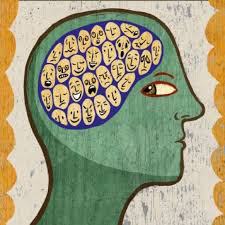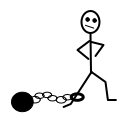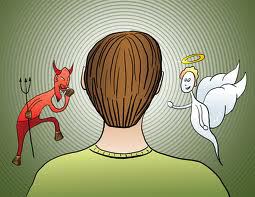In many (if not the majority) of counselling cases I work with, the client’s issue relates to some kind of confusing message – on one hand they want change, on the other they want familiarity; part of them wants to stay in the relationship, another part knows it is best to leave. Even outside of the therapeutic room and in the real world, it isn’t uncommon for people to find themselves experiencing some kind of ambivalence toward a decision or life choice. Given it is still January, I feel I can get away with mentioning New Years resolutions for one more post: how many people make decisions to change their life ‘for the better’ on January 1st to then find a huge amount of resistance to following it through? I want to stop smoking / I can’t stop smoking; I want to lose weight / I want to keep eating.
 If we tune inward, most of us will be able to find places, situations, relationships within which we notice a ‘split’. For many, the dialogue might be “I want” versus “I should”. I want to use this blog post to explain that this is a completely normal facet of our functioning as human beings, although it can create inner tension that ultimately might benefit from a therapeutic approach.
If we tune inward, most of us will be able to find places, situations, relationships within which we notice a ‘split’. For many, the dialogue might be “I want” versus “I should”. I want to use this blog post to explain that this is a completely normal facet of our functioning as human beings, although it can create inner tension that ultimately might benefit from a therapeutic approach.
I have had many clients on learning about these ‘parts of self’ existing within them exclaim “Am I going mad?”; and then the relief when we work through how normal a certain level of internal dialogue is. People fear that because they have a ‘split’ that this means a ‘split personality’ and a mental condition. There are three conditions that people have heard of, confuse, and mistakenly become fearful of:
- Bipolar disorder is characterised by alternating moods of mania and depression. A person may find themselves with high energy in one moment and then ‘crash’ into sadness and lethargy in the next. According to the Mental Health Foundation, bipolar disorder affects about one in 100 people. It is a well-understood condition, and can be treated relatively easily using a combination of medication and psychotherapy.
- Schizophrenia, less common than bipolar disorder, is characterised by having both hallucinations (seeing or hearing things that aren’t there) and delusions (belief in something that isn’t true). At least 26 million people are living with schizophrenia worldwide. Whilst therapy can be effective in this case, medication is the normal route since people with this disorder often find it difficult to interact with others – and therapy relies on relationship building (between therapist and client).
- Dissociative Identity Disorder (or its more popularised form multiple personality disorder) is characterised by a set of one or more distinct identities that a person believes to exist within themselves. These identities (often formed to help a person cope with different parts of their life) can talk to the person, and the person can answer back. Not commonly diagnosed, treatment typically involves psychotherapy to help integrate all of the identities.
These three conditions, all listed in the Diagnostic and Statistical Manual of Mental Disorders (DSM-V), need medical and therapeutic intervention. The focus for this post, and what I turn to now, is a more common way-of-being that many of us encounter and written about in many of the Western psychotherapeutic approaches.
The tyranny of the ‘shoulds’
American psychiatrist Karen Horney introduced this term in her work back in the late 1930s. It described the oscillation, a bit like a pendulum, in which we can find ourselves swaying between two (maybe more) opinions of ourselves or messages we give ourselves. In some instances, self-dialogue which includes “I should” can be appropriate and helpful (for example, to pass an exam, we probably “should” revise!) However, very often the internal dialogue is not particularly helpful or nurturing. In my work with athletes over the years I was particularly watchful of when an athlete would use language such as “I should get some longer training sessions in this weekend” (if they have missed some training due to illness of work pressure for example). I sensed I was hearing a voice from a belief they held about themselves rather than a voice speaking to the situation in the ‘now’.
It is useful to watch for language using the words “should, ought, need to, or must” – this is a common indicator that we are speaking from a deeply held belief.
 And these beliefs trip us up. They are beliefs that can, in their deepest grip, lead to a life lived imprisoned – literally like living under the power of an inner tyrant. Fritz Perls, the founder of Gestalt therapy referred to the internal “Top-dog / under-dog”. Top-dog is the part of an individual that demands adherence to certain standards (“I should be thinner”). The under-dog describes the part of an individual on the receiving end. It can feel bullied, or may make excuses explaining why these demands should not be met (many of us will know our self saboteur?).
And these beliefs trip us up. They are beliefs that can, in their deepest grip, lead to a life lived imprisoned – literally like living under the power of an inner tyrant. Fritz Perls, the founder of Gestalt therapy referred to the internal “Top-dog / under-dog”. Top-dog is the part of an individual that demands adherence to certain standards (“I should be thinner”). The under-dog describes the part of an individual on the receiving end. It can feel bullied, or may make excuses explaining why these demands should not be met (many of us will know our self saboteur?).
Where do these messages come from? Eric Berne translated many of the ideas of Freud in order to make them more accessible and thus founded Transactional Analysis. He described a model that gave three components to our ‘self’. We all (as adults) have an inner Parent and an inner Child (as well as an Adult ego that acts from a more rational place). The Parent is the internal voice that speaks from our storehouse of experiences whilst growing up. Parents, caregivers, teachers, society – examples of interactions and messages that we are exposed to as children. While recording these events, the young child has no way to filter the data; we take in the messages without question and without analysis. These ‘introjects’ (“always chew with your mouth closed!”) can exist and influence our thoughts, feelings and behaviour YEARS after the initial event. If a young child felt scared when they heard the shouted message about their eating behaviour, the inner Child of the now-adult might experience stress and anxiety when eating in public, or might grow resentful of others disobeying this held principle. In short, the introjected message gets in the way of leading a spontaneous life.
Going back to our athlete – they may wake up one morning feeling tired or with a sore throat, yet their training plan may indicate a 4 hour training session. What do they do? The athlete who has an introject of “Try harder” will hear the inner Parent say “Get up, you must train today”. The inner Child will hear this and note “…or I won’t be good enough (and I won’t be seen / loved etc), I will get up now”. Equally, we may hear the voice that says “I am tired, I want to leave work, go home and take a bath”, but ignore it in trying to appease the other part of us that is saying “You have to stay and get this pile of filing finished”.
We confuse the voice of the introject with a way to find recognition, love or to even stay safe. No wonder it has such a hold over us!
Most models of psychology have their own version of different aspects or parts of self. Like we have explored so far, many of these point to divisions that arise from ideas of how we ‘should be’ held up to some external idea (that we have then internalised). Donald Winnicott (a paediatrician working in the psychoanalytical method) describes the ‘true self’ as a sense of self that is spontaneous and seeks authentic experience. However, it is often masked by the presence of the ‘false self’, a defensive facade that in extreme cases could leave a feeling of being dead and empty. In his own words…
“Other people’s expectations can become of overriding importance, overlaying or contradicting the original sense of self, the one connected to the very roots of one’s being”
 There is another dimension. We might label the “should” voice as the part of us that brings action, that makes us lead a life worth living. In other words, we might describe this part of ourselves as ‘good’. The part-of-self that resists the introject may thus be labelled as ‘bad’. So here sets up the bind – the parental* introject is both the tyrant AND the good-guy. We hear that voice as our slave-driver, yet we make it ‘right’ and to be obeyed. This is very common with clients – they often come to counselling wanting to ‘get rid’ of the Child part or what they view (at first) as the ‘bad’ (and interestingly often the lazy) part of themselves.
There is another dimension. We might label the “should” voice as the part of us that brings action, that makes us lead a life worth living. In other words, we might describe this part of ourselves as ‘good’. The part-of-self that resists the introject may thus be labelled as ‘bad’. So here sets up the bind – the parental* introject is both the tyrant AND the good-guy. We hear that voice as our slave-driver, yet we make it ‘right’ and to be obeyed. This is very common with clients – they often come to counselling wanting to ‘get rid’ of the Child part or what they view (at first) as the ‘bad’ (and interestingly often the lazy) part of themselves.
In my next post, I will share some ways in which we can start to work on these aspects. How we first of all need to recognise the voices, allow them to be fully heard, and to then finally enter a process of negotiation between all inner aspects. It is only then that we can hope to find integration and some inner calm.
I’d love to hear from you if this post feels relevant in your life and you would like to comment. And, if you feel bound by an inner tyrant (or you may have another label you use), do get in touch to find out how we can quieten them down.
*parental introject is the most-commonly used label as on the whole, this is the predominate source from where we take our beliefs and values. It can equally apply to any adult from whom we took unfiltered messages on board.

